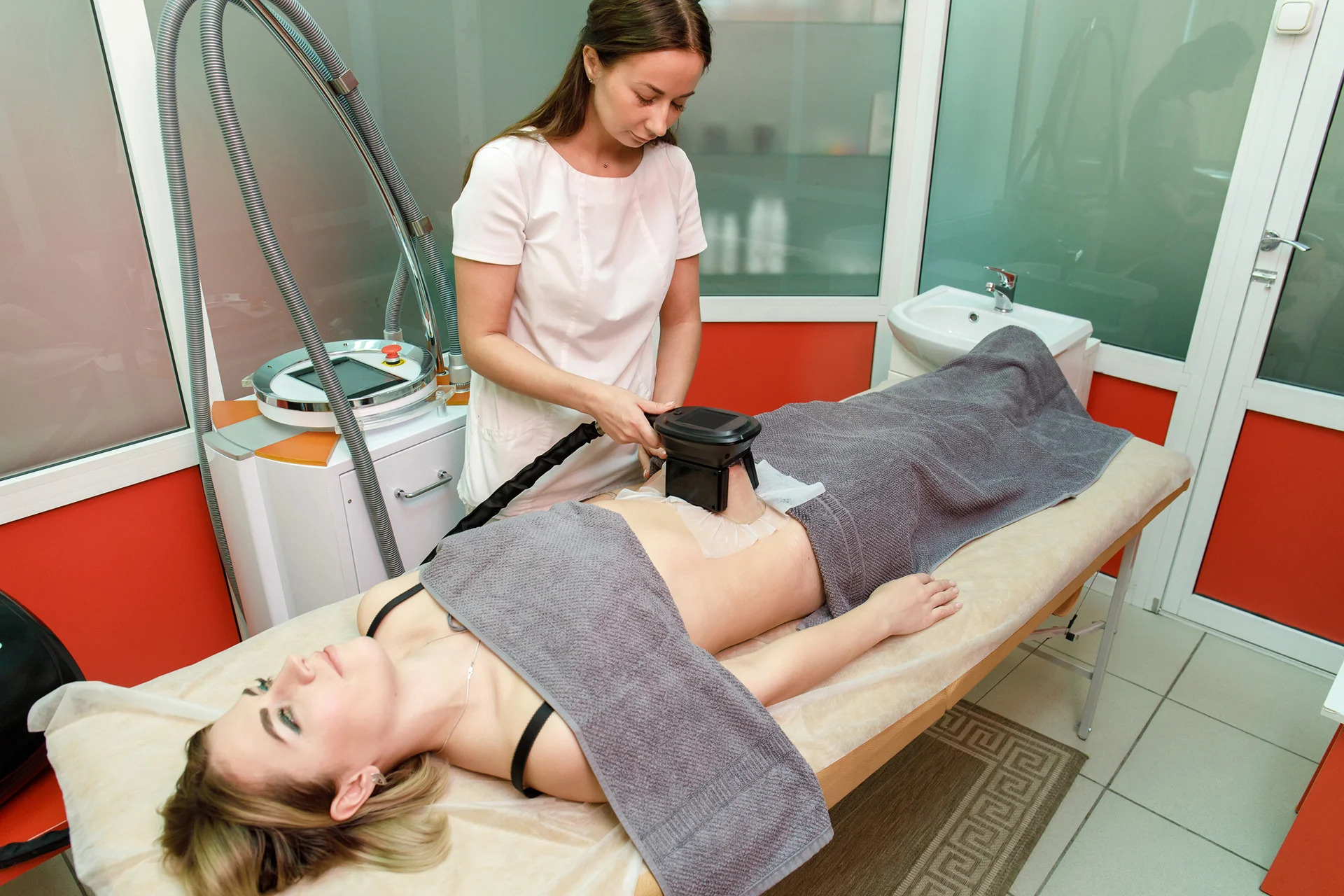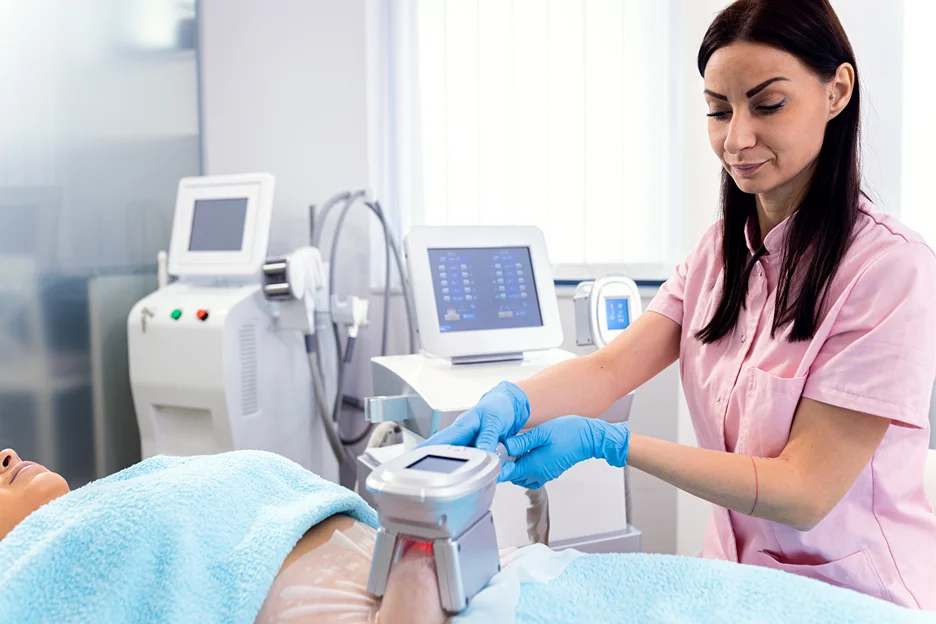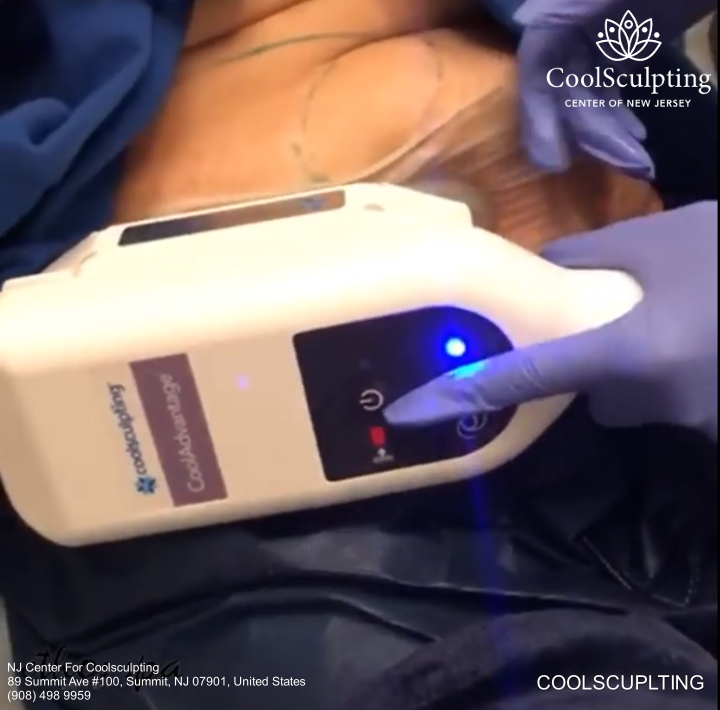Menu
(908) 628-1070

Whether it's a double chin you can't seem to shrink no matter how little you eat or excess love handles that just won't budge, stubborn pockets of body fat can be frustrating.
Thankfully, there are non-surgical options like CoolSculpting and surgical procedures such as liposuction that aim to remove these stubborn fat bulges – but which one is right for you?
Let's take a closer look at how these two fat reduction techniques stack up.
Up to 25% Fat Reduction With CoolSculpting: Treat Yourself Today!

CoolSculpting, as the name implies, uses cooling technology to sculpt your body's shape. In a literal sense, it freezes off unwanted fat cells.
During a CoolSculpting procedure, also known as cryolipolysis, a device is placed on targeted areas where excess fat accumulates.
The device applies controlled cooling to gently freeze and kill the underlying fat cells. Imagine ice cubes in a tray - as the water freezes, it expands and pushes the sides of the cube apart.
Freeze fat the same way and you get a similar effect, rupturing the cell membranes and leaving room for the immune system to sweep away the cell debris.
This fat-freezing procedure feels a bit like having an ice pack placed on your skin for about an hour while you read a magazine or watch TV in the doctor's office.
Compared to other methods of body-contouring techniques, it also requires fewer sessions:
Because CoolSculpting targets only fat cells and spares the overlying skin and surrounding tissues, there is little discomfort during the procedure. When the device is removed, you're free to go about your day as usual without much downtime or the need for pain relievers.
Over time - usually several weeks to months - your body's natural waste removal processes eliminate the dead fat cells, slowly chiseling away at those persistent pockets of pudge for a contouring effect.
Liposuction, also known as lipoplasty, involves inserting a thin tube called a cannula under the skin in the area of excess fat. The surgeon then uses vacuum-like suction to break up and remove fat cells through the cannula.
Because larger volumes of fat can be removed in a single procedure, liposuction typically produces more significant body reshaping. The drawback, however, is that liposuction is an invasive procedure that requires general anesthesia.
It also has a longer recovery period that may last several weeks with noticeable swelling, bruising and discomfort.
Like deflating a tire, when fat is suctioned out during liposuction the skin may be left with extra creases and folds - especially in those with less skin elasticity.
While damage to outer skin layers is minimized, the high fat removal rate can potentially lead to more side effects and complications.
The cell death mechanism of both procedures is Apoptosis, also known as programmed cell death. Apoptosis is a natural process that occurs in the body all the time, and it is responsible for removing old or damaged cells.
The majority of current fat reduction procedures use Apoptosis, with only high-intensity focused ultrasound using Necrosis (fat reduction via death of fat cells through injury or loss of blood supply)
Both CoolSculpting and liposuction offer solutions for banishing bothersome body fat.
Liposuction delivers more noticeable reshaping right away but involves a higher degree of invasiveness, significant discomfort, a longer recovery period and potential complications.
The optimal procedure for you depends on your health, lifestyle, expectations and ability to manage risks. An experienced cosmetic surgeon can advise you best on which option is right for targeting your specific stubborn pockets of fat.
So which is the better option for you: CoolSculpting or liposuction? There are several factors to consider.
On average, CoolSculpting costs less than liposuction. The cost of CoolSculpting ranges from about $700 to $2,000 per area treated, with multiple body areas often able to be done in the same session.
This compares to liposuction costs that typically start at $3,000 and go up to $10,000 or more, depending on the number of areas treated. The more extensive fat removal with liposuction generally commands a higher price tag.
Liposuction tends to yield greater overall fat reduction compared to CoolSculpting. While CoolSculpting can eliminate around 20%-25% of fat cells in each treated area, the effects of multiple procedures are often needed to achieve optimal results.
Liposuction, on the other hand, can remove up to several liters of fat in a single operation from areas like the abdomen, hips and thighs.
CoolSculpting allows you to resume normal activities immediately after the procedure. With liposuction, most patients need about 1-2 weeks to recover before returning to work. Strenuous exercise may be restricted for 4-6 weeks to avoid dislodging blood clots that help with healing.
Liposuction removes excess fat and a decent amount of fluid, helping to achieve a tighter and smoother silhouette. Conversely, CoolSculpting only targets fat cells. This may leave some degree of residual loose skin that requires additional skin tightening procedures.
Although liposuction produces faster, more dramatic shaping right after surgery, final results from CoolSculpting take around 4-6 months to appear as fat cells continue to be flushed away naturally. In contrast, liposuction results are essentially immediate.
So in evaluating your options, weigh factors like your lifestyle needs, pocketbook, desired degree of body contouring and willingness to undergo a medical procedure. Based on your priorities and goals, one approach may clearly emerge as the ideal fit for sculpting the body you envision.
Both CoolSculpting and liposuction aim to improve your body's shape and contours. But along with their benefits come potential risks and side effects, so it's important to go into these procedures with eyes wide open.
The good news is CoolSculpting is generally very safe when performed by a skilled practitioner. However, some discomfort and temporary side effects are common:
During the procedure, you'll likely feel intense cold from the cooling device. Some pulling or tugging sensations on the skin may also occur.
After treatment, mild soreness, swelling and bruising of the treated areas are typical for a few days. Redness and itchiness can also result, particularly as dead fat cells are cleared by the body over the next few weeks.
Paradoxical adipose hyperplasia (PAH), an uncommon complication where fat cells actually increase after treatment, occurs in less than 1% of CoolSculpting procedures. However, PAH requires corrective liposuction.
Because liposuction is a surgical procedure, side effects tend to be more severe though still manageable in most cases:
Bleeding, fluid buildup and bruising are common aftereffects, especially during the first few weeks of healing. Compression garments are often needed to help minimize swelling.
Numbness, tingling or altered sensation may occur where fat was removed. These nerve disturbances usually resolve within 6-12 months but can occasionally become permanent.
Infection is a potential - though uncommon - risk. Signs include increasing pain, redness, pus or a fever beyond a few days after surgery.
In general, the potential side effects and risks associated with liposuction tend to be more severe due to its surgical nature.
However, the overall likelihood of complications remains relatively low when the procedure is performed by a qualified and experienced cosmetic surgeon.
With either option, it's important to address any concerns proactively with your doctor to minimize potential problems.
While both CoolSculpting and liposuction offer solutions for reshaping stubborn body fat, not everyone is an ideal candidate for these procedures. Here are the main factors that determine who would do best with each option:
For best results, you should have pockets of excess fat in areas treatable by CoolSculpting like the abdomen, flanks, back of the arms, thighs and chin. At least 1 inch to 1.5 inches of fat thickness is optimal.
Your fitness level and weight should be stable. Significant weight fluctuations after CoolSculpting can reduce its effectiveness.
You should be in otherwise good health without conditions like bleeding disorders, skin infections, or vascular or autoimmune diseases that may limit your tolerance for cooling treatments.
You need realistic expectations of the degree of fat reduction and body contouring possible with CoolSculpting, as it often requires multiple sessions to achieve noticeable reshaping.
You have excess fat deposits that are resistant to traditional weight loss methods and significantly impact your body contour. Areas like the abdomen, inner thighs, hips,and upper arms are common targets.
Your general health is good enough to withstand a surgical procedure, with no uncontrolled high blood pressure, heart or diabetes complications.
You have reasonable skin elasticity to conform to changes in your body's shape following fat removal. Greater skin laxity limits how well liposuction alone can contour areas like the abdomen.
You understand that liposuction provides the most dramatic and permanent fat reduction, though it does not improve skin texture, cellulite or stretch marks. Additional procedures may be needed.
In summary, the ideal candidates for each procedure tend to vary based on their desired degree of contouring, physical tolerance for risks and realistic expectations of both techniques.
A thorough evaluation with a board-certified cosmetic surgeon can determine if you meet the criteria to be a good candidate for either CoolSculpting or liposuction.
Both CoolSculpting and liposuction aim to reshape your body's contours. But getting the most out of these procedures - and recovering comfortably - requires proper planning and follow-through on your end. Here's what to expect:
You'll likely feel soreness and minor swelling for a few days, along with temporary bruising or tenderness. Over-the-counter anti-inflammatories, applying ice and taking breaks can provide relief.
Avoid vigorous exercise or activities that raise core body temperature for at least 48 hours.
Dead fat cells eliminated by your body may cause itching, rashes or mild skin sensitivity. Moisturizer and antihistamines can help.
You can typically return to work right after treatment and resume normal daily activities.
You'll experience pain, swelling, bruising, numbness and drainage from incision sites for several weeks. Prescription medications will likely be needed.
Wear compression garments as directed and follow a low-sodium, low-sugar diet to aid healing and minimize inflammation.
Avoid strenuous activities or heavy lifting for 4-6 weeks to reduce the risk of dislodging blood clots vital for recovery.
Plan to take at least a week off work, though 2 weeks allows for more comfort as you heal.
When it comes to reshaping stubborn areas of fat, cost is an important consideration for many people. Here's how the average costs of CoolSculpting and liposuction stack up:
While CoolSculpting tends to be less expensive on a per-treatment basis, liposuction may prove more cost-effective if multiple areas need contouring to achieve your desired shape.
Both procedures represent significant investments - so it's wise to comparison shop, evaluate your financing options and have realistic expectations to ensure you get the best value for your hard-earned health care dollars.

When it comes to banishing stubborn pockets of fat, CoolSculpting and liposuction offer very different solutions. Here are the key takeaways to help you decide which may be a better fit for your needs:
The bottom line: When it comes down to it, choosing between CoolSculpting and liposuction depends largely on two factors - the degree of body reshaping you desire and your capability to manage the risks and recovery time involved.
For those seeking a gentler yet more incremental approach with minimal disruption, CoolSculpting offers a lower-risk solution.
But if you want maximum fat removal and don't mind a longer, more difficult recovery for a totally transformed silhouette, then liposuction may provide results worth the added hassle.
Ultimately, consulting with an experienced cosmetic surgeon can help you weigh the pros and cons based on your health, lifestyle and sculpting goals to determine which option truly aligns with what you hope to gain.
Armed with that personalized advice, you'll be empowered to choose wisely between these two remarkably different - yet similarly effective - techniques for banishing bothersome bulges to reveal your best body yet.
Up to 25% Fat Reduction With CoolSculpting: Treat Yourself Today!